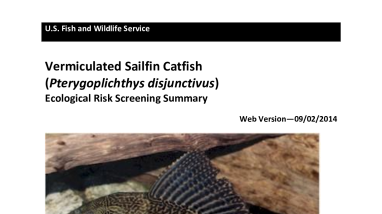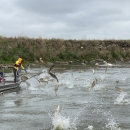Species that are considered high risk have a well-documented history of invasiveness in at least one location globally, and a high or medium climate match to the contiguous United States.
Pterygoplichthys disjunctivus is a freshwater fish native to the Madeira River basin in South America. This species has spread to several non-native countries including the U.S., where it has established populations in Florida, Texas, Mississippi, North Carolina, and Nevada. It is popular in the aquarium trade and was likely released by aquarists. While ecological impacts are mostly unknown, several sources describe negative, or potentially negative impacts. These include increased siltation, bank erosion, competition with native species for food, destruction of fishing gear, and disruption of endangered species. Pterygoplichthys disjunctivus and other members of the genus Pterygoplichthys are described by many sources as highly invasive. This species has a high climate match with the contiguous U.S. Overall risk for this species is high.



